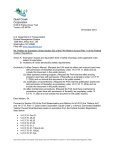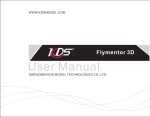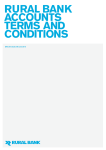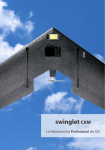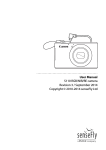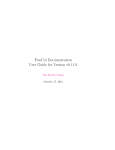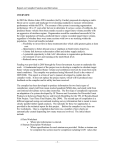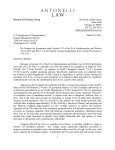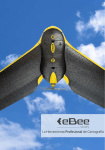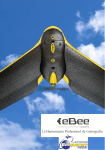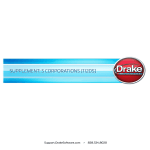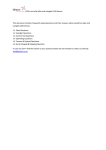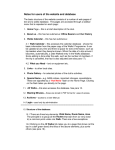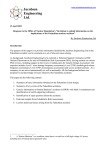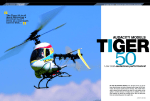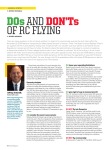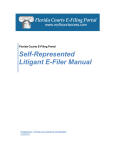Download SenseFly_Ltd_Exemption Rulemaking
Transcript
September 18th, 2014 U.S. Department of Transportation Docket Management System 1200 New Jersey Ave., SE Washington, DC 20590 Filed with www.regulations.gov Re: Petition for Exemption Under Section 333 of the FAA Reform Act and Part 11 of the Federal Aviation Regulations Dear Madam, Sir, Pursuant to Section 333 of the FAA Modernization and Reform Act of 2012 (the “Reform Act”) and 14 C.F.R. Part 11, SenseFly Ltd. (“SenseFly”), the manufacturer of the eBee Unmanned Aircraft System (“eBee”), on behalf of itself and future commercial operators of its eBee, seeks an exemption from the Federal Aviation Regulations (“FARs”) listed below: • • • • • • • • • • • • • • • 14 C.F.R. Part 21 14 C.F.R. 45.23 14 C.F.R. 45.29 14 C.F.R. 61.23 14 C.F.R. 61.3 14 C.F.R. 61.113(a) & (b) 14 C.F.R. 61.133(a) 14 C.F.R. 91.7(a) 14 C.F.R. 91.9 14 C.F.R. 91.109(a) 14 C.F.R. 91.119 14 C.F.R. 91.121 14 C.F.R. 91.151(a) 14 C.F.R. 91.203 14 CFR Subpart E (91.401 - 91.417) The requested exemption would authorize commercial operations using the eBee for mapping and precision agriculture applications. These operations will be subject to strict operating requirements SenseFly’s Petition for Exemption Under Section 333 of the FAA Reform Act and Part 11 of the Federal Aviation Regulations - Page 1 and conditions defined by the Safety Program of the Academy of Model Aeronautics (“AMA”) (see Annex B), in order to ensure at least an equivalent level of safety to currently authorized operations using manned aircrafts. Given the technical specifications of the eBee (especially its very light weight), SenseFly and the AMA think it is relevant to use the AMA rules to meet the required level of safety of operations with the eBee. Indeed, the AMA has a proven track record in supervising operations conducted by operators using Remote Control Aircrafts and provides the most relevant expertise in terms of providing safety guidelines for operators using ultra-light remote control aircrafts. Hobbyists and modelers have been safely operating unmanned aircrafts (model aircrafts) for years in compliance with AMA standards. By this petition, SenseFly seeks an exemption that will also authorize a commercial operator to use the eBee for commercial purposes provided the operator complies with any terms and conditions of SenseFly’s exemption, including the procedures and requirements set forth in the eBee user manual and the AMA Safety Program, once the operator commits to do so in a letter filed with the FAA in this docket and available in Annex C; SenseFly requests the FAA treat the eBee user manual as proprietary under 14 C.F.R. 11.35(b) and not include this document in the public docket. Similar to the practice of other agencies, which allow non-parties to a special permit or exemption to obtain the same special permit or exemption authority by submitting a letter to the agency committing itself to comply with the terms and conditions of such permit or exemption, SenseFly requests the FAA agree to grant such authority to operators upon receipt of a written commitment filed in this docket to comply with the terms and conditions of the exemption granted to SenseFly. Under this exemption, the operator would agree, if requested, to contact the FAA in order to provide the FAA with the details of the related missions and provide assurance that training and maintenance requirements are met. In the alternative, SenseFly requests the FAA to agree to process expeditiously and in an abbreviated manner petitions for an exemption filed under section 333 by an operator that intends to operate the eBee and commits to comply with the terms and conditions contained in the grant of exemption as well as in SenseFly and AMA requirements and procedures. Such petitions would not be subject to the summary publication requirement or opportunity for comment, unless the petitioner seeks additional or different exemption relief. Under the requested exemption, SenseFly and other operators of the eBee will ensure that the aircraft will be operated by an individual who meets all of the following requirements: • • • Is a registered member of the AMA; Has passed SenseFly’s training program for the eBee; SenseFly requests the FAA treat the eBee training program as proprietary under 14 C.F.R. 11.35(b) and not include this document in the public docket. Has completed an AMA-affiliated small unmanned aircraft systems (UAS) education and training program and has achieved an AMA UAS endorsement, or has successfully completed a small UAS education and training program provided by any FAA qualified entity. 1. CHARACTERISTICS OF THE AIRCRAFT The eBee is a small (38 inches wingspan) and ultra-light (maximum take-off weight of 1.7 pounds) platform made of flexible foam that performs precision aerial mapping missions thanks to the onboard GPS and the related flight management software (eMotion) that allows the operator to plan safely and efficiently a mission in 3D, and then monitor it in real-time. Thanks to the embedded camera, protected by a foam envelope, the eBee takes a collection of high-definition still images SenseFly’s Petition for Exemption Under Section 333 of the FAA Reform Act and Part 11 of the Federal Aviation Regulations - Page 2 that are used later to generate maps and contour lines of the surveyed area. The four main characteristics of the eBee are: a. Very light weight The eBee is so light that the operator can launch it by hand and let it land on almost any surface without requiring a parachute or landing net (belly land). Its low kinetic energy (60 Joules (“J”) at cruise speed) also significantly reduces the risk of hazardous situations. Finally, the wings of the eBee are detachable and made of flexible foam with no sharp or hard edges and almost no internal strengthening structure. b. Electric-powered The eBee is electric-powered. A brushless engine technology makes it silent and reliable. The propeller is attached with two rubber bands to the body of the plane so that it can easily flex away in case of contact with any object. c. Semi-automatic flight The artificial intelligence incorporated within the eBee autopilot system continuously analyzes data from the Inertial Measurement Unit and from the onboard GPS and takes care of all the aspects of the flight under the supervision of the operator. d. Option for Manual control Additionally, the eBee provides an override capability that allows the operator to take manual actions during the flight (Go to Home, Go Land, Hold and Resume the mission) and also suspend automated operations and take manual control of the aircraft should it become necessary to respond emergent circumstances, thanks to the remote controller provided with the system. 2. APPLICATIONS AND ADDED VALUE OF THE EBEE Mapping applications with the eBee may include agricultural applications, mining, construction and survey/GIS operations. The reason why the eBee solution has been very successful worldwide (thousands of operations in more than 50 countries) is that there are many operational benefits related to the use of this solution: a. First, the eBee brings safety to daily survey operations: there is no need for the humans to access dangerous working areas anymore (mines, quarries, or polluted sites). The missions can be programmed and reproduced reliably as often as needed for regularly updated maps. b. Second, the eBee is a cost-effective solution. It is cheaper to operate a UAS rather than an aircraft or other ground systems for the same results. Moreover, small UAS like the eBee can help Ag businesses and farmers face the growing needs of the population while reducing operational costs. The eBee also enables the ability to take up new challenges - like water or environmental management through analysis of vegetation index maps. c. Third, users can save time and work more efficiently by using the eBee. A mission does not need a long preparation time or long deployment constraints, or long waiting time for perfect weather conditions unlike, for example, the use of satellites. Initial results are accessible directly on-site, which is impossible with images provided by satellites or manned aircrafts. d. The eBee has social benefits too: it is eco-friendly (electric-powered), and its affordability allows many high-valued applications like data gathering for sustainability projects (agribusiness, SenseFly’s Petition for Exemption Under Section 333 of the FAA Reform Act and Part 11 of the Federal Aviation Regulations - Page 3 reforestation) or post-disaster management missions. 3. APPLICABLE LEGAL STANDARD UNDER SECTION 333 a. Airworthiness assessment of the eBee SenseFly notes that the airworthiness of the eBee has already been demonstrated for different projects in the United States, involving state/federal agencies or universities (among others the New Mexico State University: https://newscenter.nmsu.edu/Articles/view/10208/nmsu-uas-flighttest-center-conducts-ebee-airworthiness-assessment, and the US Army Corps of Engineers (“USACE”) New Orleans, who coordinated with the Department of Army and the FAA to obtain all authorizations required in order to operate the eBee UAS). Moreover, SenseFly has obtained flight approvals for the eBee from the national civil aviation authority in many countries, including: • • • • • • • • • Switzerland (flight approval for Visual Line of Sight “VLOS” operations) Canada (flight approval for VLOS operations) Australia (flight approval for VLOS operations) France (flight approval for Extended-VLOS operations) Germany (flight approval for VLOS operations) United Kingdom (flight approval for VLOS operations) Norway (flight approval for VLOS operations) Sweden (flight approval for VLOS operations) Denmark (flight approval for VLOS operations) b. Operating Conditions Grant of the exemption to SenseFly for the eBee, and for the benefit of operators of the eBee, will be subject to the following operating conditions, based on the operating conditions set forth by the AMA (see Annex B), and the factors the FAA is to consider under section 333. The main restrictions are summarized below: • • • • • • • • • • • Operations to be conducted over private, controlled-access, or public property where approved; Permission from the land owner/authority required before commencing any flight; Operations over congested areas shall be avoided; Operations must not interfere with manned aircraft operations, must yield the right of way to manned aircraft, and operators must See & Avoid other aircraft and obstacles at all times; Operations limited to Visual Flight Rules Meteorological Conditions (VMC) and daylight hours; Aircraft operations must remain within Visual Line of Sight (VLOS) and will be visually monitored at all times; VLOS guaranteed with a GPS geo-fence around operator of 0.5 miles; Flight ceiling pre-programed at 400 feet AGL; All operations conducted within 5 miles from an airport shall only be initiated after verbal coordination with the airport authority, or air traffic control when a control tower is present at the airport; All operations shall comply with required permissions and permits established by territorial, state, county or city jurisdictions; including local law enforcement, fire, or other appropriate governmental agencies; The eBee operations will be compliant with existing safety procedures inherent to the activities of the related company. SenseFly’s Petition for Exemption Under Section 333 of the FAA Reform Act and Part 11 of the Federal Aviation Regulations - Page 4 c. Operating Requirements The eBee is an ultra-light UAV platform made of flexible foam with no sharp or hard edge characterized by a high level of pre-programmed control and various built-in technical capabilities (programming of a geo-fence, automatic wind detection) that prevent the operator doing a mission outside of the operating limits. All flights are pre-programmed with GPS guidance and do not require human intervention; nevertheless human override is possible by clicking on one of the multiple “action” buttons or by using the remote controller provided with each eBee system. In the case of unplanned events, either the autopilot reacts immediately or the operator can choose between different pre-programmed or manual actions. Those procedures include a Flight Termination System (emergency landing procedure, triggered by the autopilot or the operator in charge: given its very light weight, the eBee will initiate a gliding approach to the ground at very low speed around the current location). Moreover, the kinetic energy of the aircraft is 60 J in-flight at cruise speed. In comparison, the kinetic energy of a football is about 110 J when thrown by hand. Given those safety features, recognized by the U.S. Army Corps of Engineers and the national aviation authority of several countries, SenseFly requests an exemption from the airworthiness certification requirements in Part 21 and the concomitant requirements in 14 C.F.R. 91.7(a)) and 91.203 to operate an airworthy aircraft. SenseFly also proposes that operators of the eBee should not be required to hold a commercial or private pilot certification, and hereby requests an exemption from the pilot certification requirements in the Federal Aviation Act and Part 61. Pilot certification requirements for manned aircraft are neither necessary nor appropriate in many respects for operators of small, ultra lightweight UAVs. There are undoubtedly ATP-certificated pilots who nonetheless would need training to operate a UAV safely; conversely, the UAV training regimen includes instruction for non-certificated operators in those aspects of safe operation in the National Airspace System (“NAS”) that are relevant to the UAV and the UAS operation. The FAA has authority under both section 333 and its general waiver and exemption authority in 49 U.S.C. 44701(f) to waive the statutory pilot certification requirement upon a showing that the required UAS training achieves an equivalent level of safety. To achieve as well as exceed an equivalent level of safety, operators will be required to: • • Have completed an AMA affiliated small UAS education and training program and achieved an AMA UAS endorsement, or have successfully completed a small UAS education and training program provided by any FAA qualified entity, and; Have passed SenseFly’s training program for operation of the UAS. The manufacturer’s training program for operators has been already satisfactorily reviewed through the Application for Airworthiness Qualification Level (AQL) 3 Airworthiness Release (AWR). SenseFly also seeks an exemption from certain requirements in Parts 45 and 91 that are impractical as well as unnecessary for UAS operations. Please see Annex A for a detailed explanation of each regulation from which an exemption is sought and the equivalent level of safety showing. SenseFly’s Petition for Exemption Under Section 333 of the FAA Reform Act and Part 11 of the Federal Aviation Regulations - Page 5 4. CONCLUSION SenseFly, in association with the Academy of Model Aeronautics who has a deep and well-known experience in terms of safe integration of remote controlled aircrafts in the National airspace for low-altitude operations, provides here adequate justification for the granting of the requested exemption allowing safe commercial operations of the eBee in the NAS. SenseFly offers in this petition a pragmatic approach to allow the efficient operation of ultra-light UAVs pursuant to FAA, AMA, and SenseFly safety requirements and conditions. Yours sincerely, Jean-Christophe Zufferey, SenseFly CEO SenseFly’s Petition for Exemption Under Section 333 of the FAA Reform Act and Part 11 of the Federal Aviation Regulations - Page 6 ANNEX A: EXEMPTION REQUEST AND EQUIVALENT LEVEL OF SAFETY SHOWINGS UNDER APPLICABLE RULES SUBJECT TO EXEMPTION SenseFly requests an exemption from the following regulations as well as any additional regulations that may technically apply to the operation of the eBee: 14 C.F.R. Part 21, Subpart H: Airworthiness Certificates 14 CFR § 91.203 Section 91.203 requires all civil aircraft to have a certificate of airworthiness. Part 21, Subpart H, entitled Airworthiness Certificates, establishes the procedural requirements for the issuance of airworthiness certificates as required by FAR § 91.203(a). Given the size of the eBee, its very light weight (the maximum take-off weight is 1.7 pounds) and the limited operating area associated with its utilization, it is unnecessary to go through the certificate of airworthiness process under Part 21 Subpart H in order to achieve or exceed current safety levels. Such an exemption meets the requirements of an equivalent level of safety under Part 11 and Section 333 of the Reform Act. The Federal Aviation Act and Section 333 of the Reform Act both authorize the FAA to exempt aircraft from the requirement for an airworthiness certificate, upon consideration of the size, weight, speed, operational capability, and proximity to airports and populated areas of the UAS involved. An analysis of these different criteria demonstrates that the eBee operated without an airworthiness certificate, under the conditions proposed in that exemption, will be at least as safe, or safer, than a conventional aircraft with an airworthiness certificate. A proprietary risk assessment for operations with the eBee, which demonstrates that assertion, is also being submitted to the FAA as part of this application. SenseFly requests the FAA treat the eBee risk assessment as proprietary under 14 C.F.R. 11.35(b) and not include this document in the public docket. 14 C.F.R. § 45.23 & 14 C.F.R. § 45.29: Display of marks; size of marks These regulations provide that each aircraft must display "N" and the aircraft's registration number in letters at least 3 inches high. Additionally, the aircraft must display the word "EXPERIMENTAL" in letters at least 2 inches high near the entrance to the cabin, cockpit, or pilot station. Given the size of the eBee (wingspan of 37.8 inches), this requirement is impossible to match. The equivalent level of safety will be achieved by having the upper part of the eBee stick with a copy of the AMA membership of the operator in charge. The AMA agrees to provide 2 original copies of the AMA license to every eBee operator. 14. CFR §61.23: Medical certificates: Requirement and duration Regulations provide that a person: (1) Must hold a first-class medical certificate: • • • When exercising the pilot-in-command privileges of an airline transport pilot certificate; When exercising the second-in-command privileges of an airline transport pilot certificate in a flag or supplemental operation in part 121 of this chapter that requires three or more pilots; or When serving as a required pilot flight crewmember in an operation conducted under part 121 of this chapter if the pilot has reached his or her 60th birthday. (2) Must hold at least a second class medical certificate when exercising: SenseFly’s Petition for Exemption Under Section 333 of the FAA Reform Act and Part 11 of the Federal Aviation Regulations - Page 1 • • Second-in-command privileges of an airline transport pilot certificate in part 121 of this chapter (other than operations specified in paragraph (a)(1)(ii) of this section); or Privileges of a commercial pilot certificate Given the size of the eBee, its structure, the limited flight area, and the safety features integrated in the autopilot (among others the Flight Termination System), SenseFly believes that an Equivalent Level of Safety can be reached if the operator has a valid driver’s license. 14 C.F.R. § 61.3: Requirements for certificates, ratings and authorizations 14 C.F.R. § 61.113(a) & (b); 61.133(a): Private Pilot Privileges and Limitations; Pilot in Command; Commercial Pilot Privileges and Limitations The regulation provides that no person may serve as a required pilot flight crewmember of a civil aircraft of the United States, unless that person: (1) Has a pilot certificate or special purpose pilot authorization issued under this part in that person's physical possession or readily accessible in the aircraft when exercising the privileges of that pilot certificate or authorization. However, when the aircraft is operated within a foreign country, a pilot license issued by that country may be used. The regulation provides also that no person that holds a private pilot certificate may act as pilot in command of an aircraft for compensation or hire. Subparagraph (b) allows a private pilot to act as pilot in command of an aircraft in connection with any business or employment if: (1) The flight is only incidental to that business or employment; (2) The aircraft does not carry passengers or property for compensation or hire. Given the safety features of the eBee and the fact that the missions are pre-programmed and monitored in real-time with a specific flight management software (eMotion), SenseFly proposes that operators of the eBee should not be required to hold a commercial or private pilot certification. Instead, operators should be required to: • • Have completed an AMA affiliated small unmanned aircraft systems education and training program and achieved an AMA UAS endorsement, or have successfully completed a small UAS education and training program provided by any FAA qualified entity, and; Have passed SenseFly’s training program for operation of the UAS. The manufacturer’s training program for operators has been already satisfactorily reviewed through the Application for Airworthiness Qualification Level (AQL) 3 Airworthiness Release (AWR). The equivalent level of safety will be achieved by having an operator trained by the AMA (or any FAA qualified entity) and SenseFly, and using the integrated features of the aircraft to maintain a high level of safety during the different missions. 14 C.F.R. § 91.7(a): Civil aircraft airworthiness This regulation requires that no person may operate a civil aircraft unless it is in airworthy condition. Should the exemption be granted allowing commercial operation of the eBee without an airworthiness certificate, no standard will exist for airworthiness of the eBee. Given the size of the aircraft and the previous airworthiness assessments given to the eBee, among others: • • New Mexico State University: https://newscenter.nmsu.edu/Articles/view/10208/nmsu-uasflight-test-center-conducts-ebee-airworthiness-assessment USACE New Orleans, who coordinated with the Department of Army and the FAA to obtain all authorizations required in order to operate the eBee UAS for levee system monitoring, SenseFly’s Petition for Exemption Under Section 333 of the FAA Reform Act and Part 11 of the Federal Aviation Regulations - Page 2 documentation of construction progress, and extensive oblique photography of USACE structures & activities. An equivalent level of safety will be achieved by insuring compliance with the eBee user manual prior to each flight. 14 C.F.R. § 91.9: Civil aircraft flight manual, marking, and placard requirements This regulation provides that no person may operate an aircraft unless a current, approved flight manual is in the aircraft. SenseFly assumes that the intent of this requirement is to ensure that flight manual information is available to the aircrew while operating the aircraft. SenseFly requests an exemption to this requirement since the aircraft is not only too small to carry documentation, but the documentation would not be available to the crew. The equivalent level of safety will be achieved by keeping a hard copy of the eBee user manual in the eBee transport box. 14 C.F.R. § 91.109(a): Flight Instruction The regulation provides that "No person may operate a civil aircraft that is being used for flight instruction unless that aircraft has fully functioning dual controls." Flight instruction will be accomplished through an elaborated training program, using first the simulation mode of the flight management software eMotion. The equivalent level of safety during the in-flight training will be achieved by the manufacturer or affiliate providing the training as described in the eBee training program and through the use of experienced and qualified instructors familiar with the eBee and also members of the AMA. 14 CFR § 91.119: Minimum Safe Altitudes The regulation provides that over sparsely populated areas the aircraft cannot be operated closer than 500 feet to any person, vessel, vehicle, or structure. Since the eBee will be operating at a maximum of 400 feet AGL, SenseFly cannot comply with this requirement. The equivalent level of safety will be achieved because the eBee will only fly over private property with the permission of the landowner. The operator will define before every flight a working area radius and a flight area ceiling, preventing the eBee to go beyond the flight area. The landowner and the persons who may be on the ground in the flight area will be briefed of the expected route of flight and the associated risks to persons and property on the ground. Due to the small size of the eBee, the material with which the eBee is built and its specific safety procedures (among others ground detection), the hazard to persons, vessels, vehicles, and structures is not comparable to manned aircraft and should be considered in granting the exemption. Moreover, the aircraft will not be operated over congested areas or over any open-air assembly of persons. 14 CFR 91.121: Altimeter settings This section requires that each person operating an aircraft shall maintain the cruising altitude or flight level of that aircraft, as the case may be, by reference to an altimeter that is set, when operating below 18,000 feet MSL to: • • The current reported altimeter setting of a station along the route and within 100 nautical miles of the aircraft; If there is no station within the area prescribed in paragraph (a)(1)(i) of this section, the current reported altimeter setting of an appropriate available station; SenseFly’s Petition for Exemption Under Section 333 of the FAA Reform Act and Part 11 of the Federal Aviation Regulations - Page 3 • In the case of an aircraft not equipped with a radio, the elevation of the departure airport or an appropriate altimeter setting available before departure. To provide an equivalent level of safety, the eBee autopilot calculates the reference altitude (ground level) with the on-board GPS during the pre-flight tests. The GPS and barometer data are then used to calculate the altitude in-flight. 14 C.F.R. § 91.151(a): Fuel Requirements for Flight in VFR Conditions The regulation provides that no person may begin a flight in an airplane under day-VFR conditions unless there is enough fuel to fly to the first point of intended landing and to fly after that for at least 30 minutes. As the eBee is electric-powered, this requirement is inapplicable. In any event, given the area of operation for the eBee, SenseFly believes that an equivalent level of safety is already achieved with the specific procedure preventing the eBee to accept a take-off order is the battery level is below a given value. Moreover, SenseFly has integrated “low” and “critical” battery level warnings and implemented a “return to Home” (and “Go Land”) actions in these situations. 14 C.F.R. § 91.203 (a) & (b): Carrying Civil Aircraft Certification and Registration This regulation provides as follows: • • No person may operate a civil aircraft unless it has an appropriate and current airworthiness certificate. No person may operate a civil aircraft unless the airworthiness certificate required by paragraph (a) of this section or a special flight authorization issued under §91.715 is displayed at the cabin or cockpit entrance so that it is legible to passengers or crew. To obtain an equivalent level of safety and meet the intent of 91.203, SenseFly proposes that documents deemed appropriate for this aircraft by the FAA will be co-located with the operator at the ground control station in the eBee transport box and available for inspection upon request. In order to identify the aircraft, SenseFly proposes that a copy of the AMA membership of the operator will be permanently affixed to the eBee on the upper side of the body. 14 CFR Subpart E (91.401 - 91.417): Maintenance, Preventive Maintenance, and Alterations The regulation provides that the operator is primarily responsible for maintaining the aircraft in an airworthy condition, including compliance with Parts 39 and 43. Paragraphs 91.407 and 91.409 require the aircraft to be "approved for return to service by a person authorized under 43.7" after maintenance and inspection. Section 91.409 requires an annual inspection for the issuance of an airworthiness certificate. Section 91.417 requires the owner or operator to keep records showing certain maintenance work that has been accomplished by certificated mechanics, under Part 43, or licensed pilots and records of approval of the aircraft for return to service. SenseFly proposes that the maintenance of the eBee will be accomplished by the owner or the operator according to the eBee user manual. An equivalent level of safety will be achieved because the eBee is small in size, it is not a complex mechanical device and does carry any external payload. Moreover, the operator is the person most familiar with the aircraft and is best suited to maintain the aircraft in an airworthy condition and to ensure an equivalent level of safety. Finally, before every flight, the eBee automatically runs a sequence of pre-flight tests to make sure that every sensor and every critical part is operating properly. If a problem is detected, the eBee will not be able to be switched-on and a message error is displayed on the main screen of eMotion. The owner or the operator can then refer to the eBee user manual to troubleshoot this issue. Several SenseFly’s Petition for Exemption Under Section 333 of the FAA Reform Act and Part 11 of the Federal Aviation Regulations - Page 4 parts of the eBee are easily interchangeable (propellers, wings), which allows the operator to make sure the wings and propulsion system are always airworthy when a mission is initiated. SenseFly’s Petition for Exemption Under Section 333 of the FAA Reform Act and Part 11 of the Federal Aviation Regulations - Page 5 ANNEX B: ACADEMY OF MODEL AERONAUTICS SAFETY REQUIREMENTS http://www.modelaircraft.org/files/105.pdf http://www.modelaircraft.org/files/540-D.pdf http://www.modelaircraft.org/files/560.pdf SenseFly’s Petition for Exemption Under Section 333 of the FAA Reform Act and Part 11 of the Federal Aviation Regulations - Page 1 ANNEX C: PROPOSITION OF DOCUMENT TO BE FILLED OUT BY EVERY OPERATOR Section 1: Organization Contact Details • Organization: • Organization Address: • Organization Phone Number: • Website of the Company: • Organization Contact Full Name: • Contact Phone number: • Contact email address: Section 2: Operator(s) Contact Details • Operator First Name: • Operator Middle Name (optional): • Operator Last Name: • Primary Phone Number: • Email address: • Secondary Phone Number: • AMA Membership Number: Note: Add the above-requested information for each operator. Section 3: Operator’s Certifications 1.a. The operator(s) has (have) successfully accomplished AMA’s training regimen and received an AMA endorsement (please provide a copy of the certificate(s)); or has (have) successfully accomplished a training program performed by a FAA qualified entity: Yes: ! / No: ! 1.b. The operator(s) has (have) successfully accomplished SenseFly specific training program for the related UAV (please provide a copy of the certificate(s)): Yes: ! / No: ! 2. The operator(s) has (have) reviewed the operating requirements described in the Petition for Exemption filled out by SenseFly and agrees to comply with those operating requirements: SenseFly’s Petition for Exemption Under Section 333 of the FAA Reform Act and Part 11 of the Federal Aviation Regulations - Page 1 Yes: ! / No: ! Section 4: Description of Operations • Enter the number of UAVs you are registering: • Enter the serial numbers, if possible, for the UAVs you are registering: • Briefly describe the purpose of your proposed operation(s): • Describe the times of day in which you plan to operate: • Enter how many observers will be present for each UAV type of operation: Section 5: Description of Additional Operating Procedures • Describe how you will maintain communication with operators on the ground: • Describe the additional safety procedures you propose to use: • Describe any other factors you deem important: Date: Full name: Signature: SenseFly’s Petition for Exemption Under Section 333 of the FAA Reform Act and Part 11 of the Federal Aviation Regulations - Page 2














